Reactive & Efficient: Organic Azides as Cross-Linkers in Material Sciences
- PMID: 32102403
- PMCID: PMC7070646
- DOI: 10.3390/molecules25041009
Reactive & Efficient: Organic Azides as Cross-Linkers in Material Sciences
Abstract
The exceptional reactivity of the azide group makes organic azides a highly versatile family of compounds in chemistry and the material sciences. One of the most prominent reactions employing organic azides is the regioselective copper(I)-catalyzed Huisgen 1,3-dipolar cycloaddition with alkynes yielding 1,2,3-triazoles. Other named reactions include the Staudinger reduction, the aza-Wittig reaction, and the Curtius rearrangement. The popularity of organic azides in material sciences is mostly based on their propensity to release nitrogen by thermal activation or photolysis. On the one hand, this scission reaction is accompanied with a considerable output of energy, making them interesting as highly energetic materials. On the other hand, it produces highly reactive nitrenes that show extraordinary efficiency in polymer crosslinking, a process used to alter the physical properties of polymers and to boost efficiencies of polymer-based devices such as membrane fuel cells, organic solar cells (OSCs), light-emitting diodes (LEDs), and organic field-effect transistors (OFETs). Thermosets are also suitable application areas. In most cases, organic azides with multiple azide functions are employed which can either be small molecules or oligo- and polymers. This review focuses on nitrene-based applications of multivalent organic azides in the material and life sciences.
Keywords: azides; nitrenes; photochemistry; polymers; thermosets.
Conflict of interest statement
The authors declare no conflict of interest.
Figures






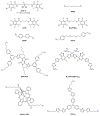

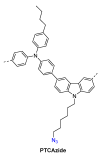

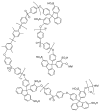



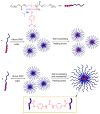
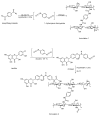


Similar articles
-
Quick and highly efficient copper-catalyzed cycloaddition of organic azides with terminal alkynes.Org Biomol Chem. 2012 Jan 14;10(2):229-31. doi: 10.1039/c1ob06190a. Epub 2011 Oct 24. Org Biomol Chem. 2012. PMID: 22024945
-
Electrophilic Azides for Materials Synthesis and Chemical Biology.Acc Chem Res. 2020 Apr 21;53(4):937-948. doi: 10.1021/acs.accounts.0c00046. Epub 2020 Mar 24. Acc Chem Res. 2020. PMID: 32207916 Review.
-
Copper-catalyzed Huisgen 1,3-dipolar cycloaddition under oxidative conditions: polymer-assisted assembly of 4-acyl-1-substituted-1,2,3-triazoles.J Org Chem. 2013 Jul 5;78(13):6540-9. doi: 10.1021/jo400800j. Epub 2013 Jun 14. J Org Chem. 2013. PMID: 23738944
-
Synthesis of 1-Cyanoalkynes and Their Ruthenium(II)-Catalyzed Cycloaddition with Organic Azides to Afford 4-Cyano-1,2,3-triazoles.J Org Chem. 2018 May 4;83(9):5092-5103. doi: 10.1021/acs.joc.8b00424. Epub 2018 Apr 13. J Org Chem. 2018. PMID: 29630830
-
Recent Advances in Recoverable Systems for the Copper-Catalyzed Azide-Alkyne Cycloaddition Reaction (CuAAC).Molecules. 2016 Sep 5;21(9):1174. doi: 10.3390/molecules21091174. Molecules. 2016. PMID: 27607998 Free PMC article. Review.
Cited by
-
Real-Time Observation of Clickable Cyanotoxin Synthesis in Bloom-Forming Cyanobacteria Microcystis aeruginosa and Planktothrix agardhii.Toxins (Basel). 2024 Dec 5;16(12):526. doi: 10.3390/toxins16120526. Toxins (Basel). 2024. PMID: 39728784 Free PMC article.
-
Tris(4-azidophenyl)methanol - a novel and multifunctional thiol protecting group.RSC Adv. 2023 Jan 17;13(4):2483-2486. doi: 10.1039/d2ra05997e. eCollection 2023 Jan 11. RSC Adv. 2023. PMID: 36741178 Free PMC article.
-
4-Azidocinnoline-Cinnoline-4-amine Pair as a New Fluorogenic and Fluorochromic Environment-Sensitive Probe.Molecules. 2021 Dec 9;26(24):7460. doi: 10.3390/molecules26247460. Molecules. 2021. PMID: 34946541 Free PMC article.
-
Optimization of fluorinated phenyl azides as universal photocrosslinkers for semiconducting polymers.Nat Commun. 2024 Jul 28;15(1):6354. doi: 10.1038/s41467-024-50257-5. Nat Commun. 2024. PMID: 39069548 Free PMC article.
-
Interfacial Nanoengineering of Hydrogel Surfaces via Block Copolymer Self-Assembly.ACS Appl Mater Interfaces. 2025 Feb 12;17(6):10073-10086. doi: 10.1021/acsami.4c18632. Epub 2025 Feb 3. ACS Appl Mater Interfaces. 2025. PMID: 39901519 Free PMC article.
References
-
- Griess P. On a new series of bodies in which nitrogen is substituted for hydrogen. Philos. Trans. R. Soc. Lond. 1864;154:667–731. doi: 10.1039/JS8651800268. - DOI
-
- Hepher M., Wagner H.M. Azide Resin Photolithographic Composition. No. US2852379A. US Patent. 1958 Sep 16;
-
- Manchado M.A.L., Kenny J.M. Use of benzene-1,3-bis(sulfonyl)azide as crosslinking agent of TPVS based on EPDM rubber-polyolefin blends. Rubber Chem. Technol. 2001;74:198–210. doi: 10.5254/1.3544944. - DOI
-
- Baker D.A., East G.C., Mukhopadhyay S.K. Mechanical and thermal properties of acrylic fibers crosslinked with disulfonyl azides. J. Appl. Polym. Sci. 2002;84:1309–1319. doi: 10.1002/app.2349. - DOI
-
- Avadanei M., Grigoriu G.E., Barboiu V. Photocrosslinking of poly-1,2-butadiene in the presence of benzophenone and aromatic diazide. Rev. Roum. De Chim. 2003;48:813–819.
Publication types
MeSH terms
Substances
Grants and funding
LinkOut - more resources
Full Text Sources
Other Literature Sources

